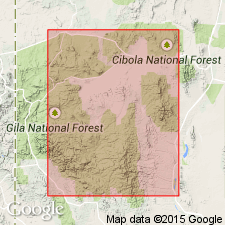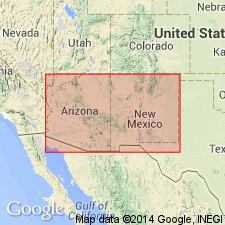
- Usage in publication:
-
- Sacaton Quartz Latite
- Modifications:
-
- Named
- Dominant lithology:
-
- Quartz latite
Summary:
Named for Sacaton Mountain, its type locality in the Wilcox mining district [location not given]. Shown as a felsic flow younger than Cranktown? Sandstone and older than Mineral Creek Andesite on figure 2, otherwise no lithologic description given. Is in part equivalent to the Pacific Quartz Latite. [Description inadequate for a new name]. Is of Tertiary age.
Source: GNU records (USGS DDS-6; Denver GNULEX).

- Usage in publication:
-
- Sacaton Quartz Latite
- Modifications:
-
- Paleomagnetics
- AAPG geologic province:
-
- Basin-and-Range province
Summary:
In Sheridan Gulch area, Catron Co, NM, Basin-and-Range province, Sacaton Quartz Latite was found to be similar to Pacific Quartz Latite in its direction of magnetization and its magnetic stability--undoubtedly correlates directly with Pacific in the Mogollon area (Pacific Quartz Latite, which correlates approximately with Apache Spring Quartz Latite, is very stable magnetically, but it has an unusual direction of magnetization--therefore, it probably cooled rapidly during a time when the field was reversing. Both in its direction of magnetization and in its magnetic properties, Pacific bears a surprising similarity to Taylor Creek Rhyolite, but is distinctly older). Apache Spring Quartz Latite in some locations is reversely magnetized, so it may have trapped a transition zone--therefore, correlates directly with Sacaton. Magnetostratigraphic position of Sacaton and Apache Spring units within a preliminary model of the middle Tertiary paleomagnetic reversal pattern is depicted on fig. 5; Taylor Creek is depicted on fig. 4.
Source: GNU records (USGS DDS-6; Denver GNULEX).
For more information, please contact Nancy Stamm, Geologic Names Committee Secretary.
Asterisk (*) indicates published by U.S. Geological Survey authors.
"No current usage" (†) implies that a name has been abandoned or has fallen into disuse. Former usage and, if known, replacement name given in parentheses ( ).
Slash (/) indicates name conflicts with nomenclatural guidelines (CSN, 1933; ACSN, 1961, 1970; NACSN, 1983, 2005, 2021). May be explained within brackets ([ ]).

